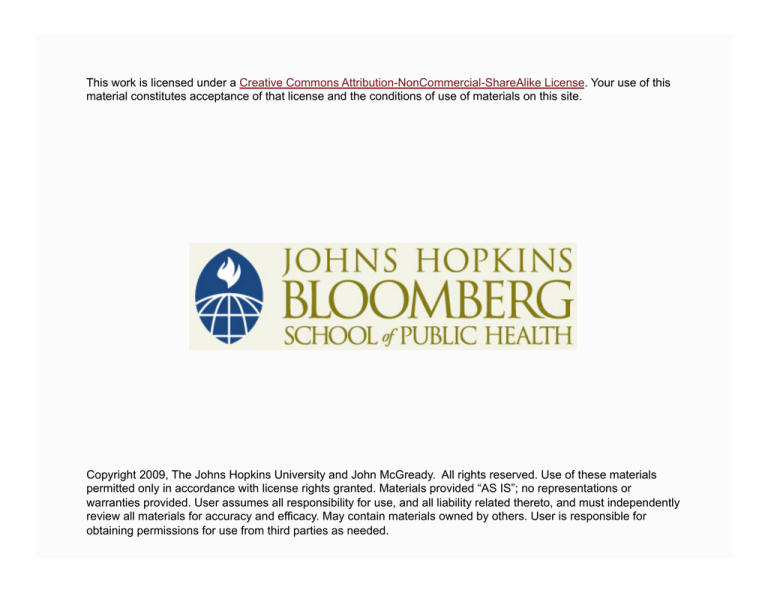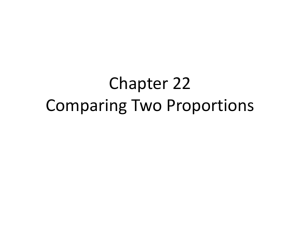
This work is licensed under a Creative Commons Attribution-NonCommercial-ShareAlike License. Your use of this
material constitutes acceptance of that license and the conditions of use of materials on this site.
Copyright 2009, The Johns Hopkins University and John McGready. All rights reserved. Use of these materials
permitted only in accordance with license rights granted. Materials provided “AS IS”; no representations or
warranties provided. User assumes all responsibility for use, and all liability related thereto, and must independently
review all materials for accuracy and efficacy. May contain materials owned by others. User is responsible for
obtaining permissions for use from third parties as needed.
Comparing Proportions between Two Independent
Populations
John McGready
Johns Hopkins University
Lecture Topics
Using CIs for difference in proportions between two independent
populations
Large sample methods for comparing proportions between two
populations
- Normal method
- Chi-squared test
Fisher’s exact test
Relative risk
3
Section A
The Two Sample z-Test for Comparing Proportions
between Two Independent Populations: The Confidence
Interval Approach
Comparing Two Proportions
We will motivate by using data from the Pediatric AIDS Clinical Trial
Group (ACTG) Protocol 076 Study Group*
Study design
- “We conducted a randomized, double-blinded, placebocontrolled trial of the efficacy and safety of zidovudine (AZT) in
reducing the risk of maternal-infant HIV transmission”
- 363 HIV infected pregnant women were randomized to AZT or
placebo
Notes: *Conner, E., et al. (1994). Reduction of maternal-infant transmission of human immunodeficiency virus type 1 with
zidovudine treatment, New England Journal of Medicine 331: 18.
5
Comparing Two Proportions
Results
- Of the 180 women randomized to AZT group, 13 gave birth to
children who tested positive for HIV within 18 months of birth
- Of the 183 women randomized to the placebo group, 40 gave
birth to children who tested positive for HIV within 18 months
of birth
6
Notes on Design
Random assignment of Tx
- Helps insure two groups are comparable
- Patient and physician could not request particular treatment
Double blind
- Patient and physician did not know treatment assignment
7
Observed HIV Transmission Proportions
AZT
Placebo
8
HIV Transmission Proportions: 95% CIs
9
Notes on HIV Transmission Proportions
Is the difference significant, or can it be explained by chance?
Since CIs do not overlap suggests significant difference
- Can we compute a confidence interval on the difference in
proportions?
- Can we compute a p-value?
10
Sampling Distribution: Difference in Sample Proportions
Since we have large samples we know the sampling distributions of
the sample proportions in both groups are approximately normal
It turns out the difference of quantities, which are (approximately)
normally distributed, are also normally distributed
11
Sampling Distribution: Difference in Sample Proportions
So, the big news is . . .
- The sampling distribution of the difference of two sample
proportions, each based on large samples, approximates a
normal distribution
- This sampling distribution is centered at the true (population)
difference, p1 - p2
12
Sampling Distribution: AZT Group
Simulated sampling distribution of sample proportion: AZT group
13
Sampling Distribution: Difference in Sample Proportions
Simulated sampling distribution of sample proportion: placebo group
14
Sampling Distribution: Difference in Sample Proportions
Simulated sampling distribution of difference in sample proportions:
AZT - placebo
15
95% Confidence Interval for Difference in Proportions
Our most general formula
The best estimate of a population difference based on sample
proportions:
Here,
may represent the sample proportion of infants HIV
positive (within 18 months of birth) for 180 infants in the AZT group,
and
may represent the sample proportion of infants HIV positive
(within 18 months of birth) for 183 infants in the AZT group
16
95% CI for Difference in Proportions: AZT Study
So,
for p1 - p2 is:
Where
proportions
: hence the formula for the 95 CI
= standard error of the difference of two sample
17
Standard Error of Difference in Proportions
Statisticians have developed formulas for the standard error of the
difference
These formulas depend on sample sizes in both groups and sample
proportions in both groups
The
-
is greater than either
Why do you think this is?
or
18
Principle
Variation from independent sources can be added
- Why do you think this is additive?
Of course, we don’t know p1 and p2: so we estimate with
get an estimated standard error:
and
to
19
Comparing Two Independent Groups: HIV/AZT Study
Recall the data from the Infant HIV/ AZT study
Group
AZT
Placebo
Number of subjects (n)
64
68
Proportion Infants HIV+
Within 18 Months
0.07
0.22
20
95% CI for Difference in Proportions: HIV/ AZT Study
So in this example, the estimated 95% for the true difference in
proportions of infants contracting HIV between the AZT and placebo
groups:
21
Summary: AZT Study
Results
- The proportion of infants who tested positive for HIV within 18
months of birth was seven percent (95% CI 4 -12%) in the AZT
group and twenty-two percent in the placebo group
(95% CI 16 - 28%)
- The study results estimate the absolute decrease in the
proportion of HIV positive infants born to HIV positive mothers
associated with AZT to be as low as 8% and as high as 22%
22






